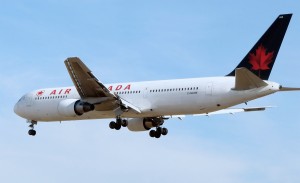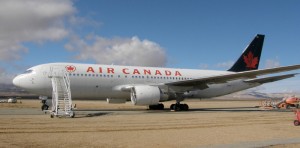Published July 23, 2012
By Thomas Van Hare
On this date in aviation history in 1984, Air Canada Flight 143, a Boeing 767, unexpectedly ran out of fuel while at Flight Level 410 (41,000 feet). The airliner was en route to Edmonton from Montreal, Canada, and was carrying 61 passengers. In the cockpit were two experienced pilots, Captain Robert Pearson and First Officer Maurice Quintal. It is likely that had any other two pilots been on board, the aircraft would have crashed, probably with no survivors. Instead, the pilots pulled a miracle out of their combined, unique experience. This is the story of the miracle known as the “Gimli Glider”.
Suddenly Things Got Really Quiet
For Flight 143, things happened in horrifyingly rapid sequence. For the two pilots, the first sign of trouble came when a warning horn sounded indicating a lack of fuel pressure. As per standard procedure, the pilots switched off the fuel pump. Gravity alone would still feed fuel to the engines and this was an eventuality that was well-practiced. Moments later, however, the left engine died, which didn’t make sense given the fuel pressure warning and action taken. The two pilots immediately commenced the standard single engine emergency procedures checklist, as practiced hundreds of times. They declared an emergency over the radio to Air Traffic Control and took a heading toward Winnepeg, planning an emergency landing. The flight management system confirmed their fuel quantities were still sufficient (later they would realize that since the initial fuel quantity had been improperly entered). Descending, they commenced the engine restart sequence on the left engine.

These were all common emergency situations for which they had trained extensively — indeed, a Boeing 767 has the capability of flying around for many hours on a single engine if it was absolutely necessary. With professionalism, they proceeded through the restart attempt. However, just then, another warning horn sounded, one that they had never heard before, even in simulators — it was a sort of a “bong” noise, as they would later describe it. There was a “what was that?” moment before the right engine abruptly quit. Suddenly, they were flying an airliner with both engines out — and at that, the instrument panel died, as did all electrical indicators and lighting. The EFIS (Electronic Flight Instrument System) and all other electrical devices on the plane draw power from one or both of the engines.
The pilots were left with a few essential flight instruments only — a small emergency stack that ran off of battery power. With both engines offline, the pilots realized that hydraulic power was also lost. Thankfully, the aircraft design included an emergency ram air system that provided hydraulic power when deployed, a sort of small pop-out generator with a tiny prop on its nose (incidentally, this system was pioneered on Republic’s XF-84H Thunderscreech, the subject of yesterday’s Daily Flight Story). So long as sufficient airspeed was maintained, the little ram air system would provide sufficient hydraulic pressure for flight control — yet that required a speed well above their best landing speed.
What Emergency Procedures?
The two pilots quickly checked the Boeing 767 books for a two engine out checklist, only to find that there was no such thing — they would have to make it up as they went along. Fortuitously, Captain Pearson happened to be an amateur glider pilot. He immediately treated the B767 as if it were a giant glider and made an educated guess of his best glide speed — 220 KIAS (something that was also not published). Then, he realized that there were no instruments giving him his vertical speed (aka “sink rate”). How far would the jet glide? Could they make Winnipeg? With the aid of the air traffic controllers, they cross-referenced position information with the altitude read-out from their emergency altimeter. They would fall short of Winnipeg. Worse yet, there seemed to be no long enough runways in gliding range.
At that, the second fortuitous event took place — First Officer Quintal, a former RCAF pilot, had once been based at RCAF Station Gimli, a base that had closed twelve years earlier in 1971. He knew it was ahead and within gliding distance. The old military airfield was now listed as a small town private airport with a short runway. Quintal knew that a second longer runway was also there — and it was not only their best option, it was their only option. However, what they didn’t know was that a major part of the longer runway at Gimli had been converted into Gimli Motorsports Park, with a go-kart track, road race course and drag strip. Further, by sheer coincidence, that very day a CASC amateur sports car race was being run at the airfield. The grass alongside the longer closed runway was being used for camper and RV parking with spectators walking around.
Final Approach
As the two pilots lined up the B767 at Gimli, without sufficient hydraulic pressure, they tried a gravity drop of the landing gear. Since they were coming in fast, however, the nose wheel didn’t lock down. It would certainly collapse on landing. As the runway loomed ahead, the pilots also recognized that they were too high and too fast. They also discovered that they couldn’t deploy the flaps or slats to slow the plane for a landing, since the plane’s emergency hydraulic system wasn’t producing enough pressure. Once again, Captain Pearson’s glider pilot skills kicked in. To slow down and lose altitude, he put the huge Boeing 767 into a forward slip, skidding it sideways by cross-controlling the ailerons and rudder.

As speed and altitude bled off, however, hydraulic power dwindled, making it difficult to control the plane. Nonetheless, Captain Pearson somehow wrestled the plane onto the runway. He stood on the brakes as the plane touched down, burning out the brake system. As expected, the nose wheel collapsed and the plane fell forward — the nose scraping on the ground. Fortuitously, this further slowed the plane, yet the friction caused from sliding to a stop ignited a fire under the nose and cockpit. At this point, a third bit of good fortune resulted when the nearby race car pit crews working that day at the raceway jumped to the rescue with their firefighting gear. They quickly extinguished the blaze before it spread up the fuselage into the passenger cabin.
Aftermath
All 61 passengers and the entire crew survived the landing without injury, although some would suffer minor injuries when exiting the emergency slides at the aircraft’s tail. With the nose down, the tail was too high to allow the slides to touch the ground, causing those who exited out the back to fall from a height to the ground. All in all, it had been a surprisingly lucky day. When “reflying” the incident in simulators, Air Canada found that few other pilots could achieve what Captain Pearson and FO Quintal had done, making their achievement all the more incredible. Ultimately, the press and the public would celebrate the flight crew as heroes and would dub the incident the “Gimli Glider.”
One More Bit of Aviation Trivia
In the wake of the accident, Air Canada’s investigation found Captain Pearson and First Officer Quintal as well as the mechanics to be at fault for running out of fuel in the first place. Captain Pearson was demoted for six months to First Officer and FO Quintal was suspended for two weeks. However, Canada’s Air Safety Board differed and found the airline at fault, commending the pilots for “professionalism and skill” in making the landing. Investigations would reveal that the fuel shortage occurred in large part due to a mix-up between the Imperial and metric systems of measurement, to which Canada had recently converted. This was compounded by a failure of the airline to properly change operating procedures and reassign the fuel checks to the FO after the third flight crew position, the Flight Engineer, was stricken from the standard crew manifest. The two would be reinstated and finish out their careers, joining the ranks of hero pilots in the eyes of the public and forever being remembered as the guys who safely landed the “Gimli Glider”.


From an old piston pilot, WELL DONE!!!!! Dead-sticked a few test a/c over the years, PISTON > T-28B and S2F. Damn, good recall, you two.
Glider pilots have always been the better pilots. Cf. Capt. Sullenberger.
Tailwinds
Henning Hiepe, Heidelberg, Germany
How can I contact Gimli glider pilot Bob Pearson? We would like him to speak at our Nuclear Operations training session.